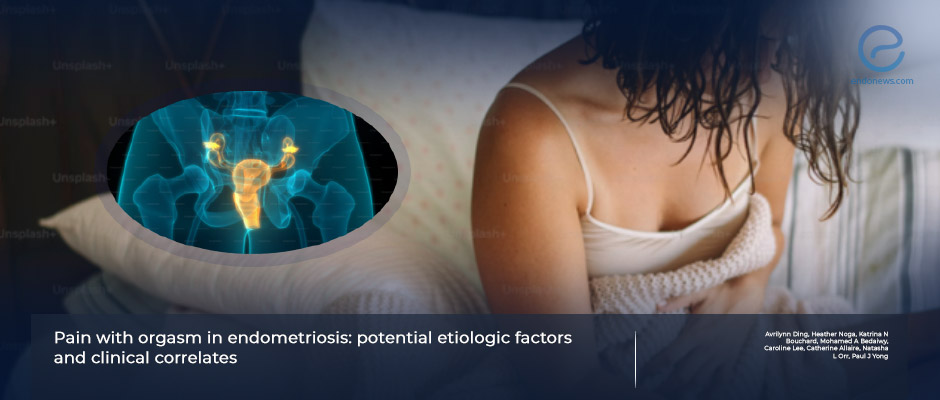Exploring the underlying causes of orgasm-related pain in endometriosis
Nov 14, 2024
Orgasm-related Pain, Uterine Contractions, Pelvic Floor Myalgia, and Central Sensitization
Key Points
Highlight
- Targeted therapies aimed at pelvic floor dysfunction and central sensitization may offer relief for endometriosis patients experiencing orgasm-related pain.
Importance
- Investigating the relationship between pelvic floor dysfunction and orgasm-related pain in endometriosis could lead to more focused, symptom-specific treatments.
- Recognizing central nervous system sensitization as a factor suggests that multidisciplinary approaches may be essential for managing pain in endometriosis.
What’s done here
- This is a prospective registry analysis investigating the prevalence of orgasm-related pain and its potential causes in endometriosis patients.
- Using data from the Endometriosis Pelvic Pain Interdisciplinary Cohort, multiple variables were evaluated as related factors.
Key results
- Forty-nine patients (14%) reported worsening pelvic pain with orgasm.
- They had higher rates of pelvic floor myalgia and Central Sensitization Inventory score.
- Worse sexual health outcomes,including deep dyspareunia and sexual distress were also noted
- Pain with orgasm also correlated with elevated anxiety and depression scores, as well as greater chronic pelvic pain.
- No significant differences were found in uterine tenderness or adenomyosis between groups.
- Ovarian endometriosis was less common among those with orgasm-related pain.
Limitations
- Sample size, Binary pain measurement, Use of single-center data are major limitations.
Lay Summary
As one of the most common symptoms of endometriosis, pain may involve peripheral or central mechanisms resulting in different pain sensations. Female orgasm pain is an underexplored condition associated with pelvic floor myalgia and uterine factors like adenomyosis, likely due to the rhythmic contractions of the pelvic floor and cervico-uterine muscles during orgasm.
Ding et al. from Vancouver, Canada conducted a prospective registry analysis aiming to evaluate how common orgasm-related pelvic pain is in patients with endometriosis and investigate its links to possible causes, including pelvic floor myalgia, uterine tenderness, adenomyosis, and central nervous system sensitization. The study was published in the September 2024 issue of The Journal of Sexual Medicine.
Data was obtained from a prospective data registry called Endometriosis Pelvic Pain Interdisciplinary Cohort based at a tertiary referral center, which investigates pelvic pain in endometriosis patients, focusing on pain exacerbated by orgasm and related factors. Participants were adults diagnosed with endometriosis who were evaluated from 2018 to 2019, and completed pre- and post-surgical assessments. Key variables included demographic details, uterine tenderness, adenomyosis, sexual health, dyspareunia, and other pain types. Pain comorbidities and central sensitization were assessed, considering pelvic floor myalgia, irritable bowel syndrome, and anxiety/depression. Surgical findings and diagnostic markers, such as endometriosis stage and pelvic structural abnormalities, were documented and all the variables were statistically analyzed.
Of 358 participants with endometriosis, 14% reported pelvic or lower abdominal pain worsened by orgasm. Associations between this pain type and pelvic floor myalgia, higher central sensitization scores, and increased severity of dyspareunia, chronic pelvic pain, sexual distress, anxiety, and depression were found, however, there were no links with uterine tenderness or adenomyosis. The authors suggested that pelvic floor dysfunction could contribute to orgasm-related pain, and physiotherapy might be beneficial.
They commented that central sensitization may intensify pain related to somatic rather than visceral sources, as evidenced by the lack of associations with conditions like irritable bowel syndrome. No significant correlation with endometriosis anatomy at surgery was noted, aside from a non-significant trend suggesting lower rates of orgasm-associated pain in participants with ovarian endometriosis.
The authors conclude that orgasm-related pelvic pain in endometriosis may stem from pelvic floor myalgia and central nervous system sensitization, suggesting targeted treatment could improve outcomes.
Research Source: https://pubmed.ncbi.nlm.nih.gov/39039031/
endometriosis pain orgasm central sensitization

